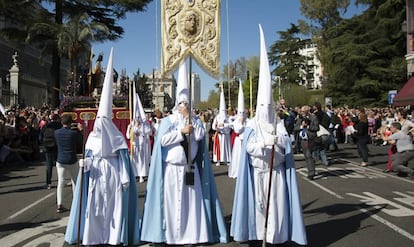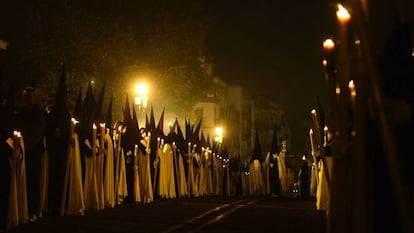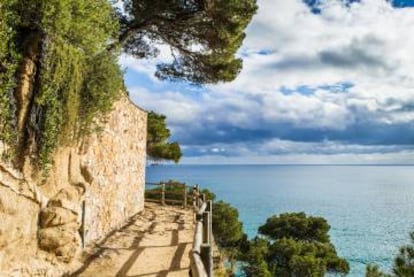A quick guide to Easter in Spain
Helpful tips about traffic, the weather and what to do over this year’s Easter break

Whether you are traveling for the long weekend or staying at home, here is information that will help make your break a pleasant one.
Weather
After two days of sunshine and warm weather, Spain’s meteorology agency Aemet is warning that temperatures will drop by 8 to 10ºC across most of the country. Along the northeast and southeast coasts, temperatures are expected to remain more or less the same. But rain is forecast for the coastal regions in Galicia, and the rest of the country can expect cloudy weather and lower temperatures from Thursday onwards. The weather is expected to improve by late Saturday, when Aemet is predicting higher temperatures and clearer skies.

Traffic
The Spanish traffic authority (DGT) predicts that nine million cars will flood the roads between Wednesday and Sunday for the Easter break holidays. According to the Interior Ministry, a total of 15.5 million cars will make road trips throughout Easter week – a two percent increase from last year’s figures. Most people are leaving on Thursday and heading for the south of Spain. On Friday and Saturday, the traffic is expected to ease everywhere but Catalonia, Valencia and Cantabria, where Thursday is not a holiday. According to the DGT, most travelers will return between noon and 11pm on Sunday night and during the same period on Monday – especially in provinces where April 2 is a holiday. The DGT has launched a special Easter week operation with 291 motorcycle patrols, to catch people speeding and driving under the influence.
Things to do

There are many ways to enjoy the Easter break in Spain. In Madrid, you can watch a procession in memory of the passion of Christ (see complete program), listen to religious music – including flamenco saetas on Holy Friday, or attend a hip-hop dance marathon in the Casa Encendida. Andalusia is a reference point for Easter processions, which are held across the region. Those in the city of Seville are particularly well known for their elaborate aesthetics and devout public.

In Catalonia, consider taking a hot air balloon over orchards in Lleida, star-gazing at the observatory in Montsec, or discovering the trails that wind around Costa Brava. In Galicia, visitors can enjoy an international piano competition – the first in Spain without an age limit, as well as a fair dedicated to Queixo do Cebreiro, a local cheese made from cow’s milk, on March 30. If you are in Valencia, don’t miss the celebrations in honor of the saint of the sea, or Santa Marinera. Processions and parades will be held on Thursday, Friday and Sunday. In Basque Country, follow the wine train in Rioja Alavesa, pay a visit to the Guggenheim museum or try out the txotx cider tradition – where you get to pour cider direct from the barrel.
For more ideas, take a look at the best beaches to visit in Spain and the country’s most impressive lookout points.
Tu suscripción se está usando en otro dispositivo
¿Quieres añadir otro usuario a tu suscripción?
Si continúas leyendo en este dispositivo, no se podrá leer en el otro.
FlechaTu suscripción se está usando en otro dispositivo y solo puedes acceder a EL PAÍS desde un dispositivo a la vez.
Si quieres compartir tu cuenta, cambia tu suscripción a la modalidad Premium, así podrás añadir otro usuario. Cada uno accederá con su propia cuenta de email, lo que os permitirá personalizar vuestra experiencia en EL PAÍS.
¿Tienes una suscripción de empresa? Accede aquí para contratar más cuentas.
En el caso de no saber quién está usando tu cuenta, te recomendamos cambiar tu contraseña aquí.
Si decides continuar compartiendo tu cuenta, este mensaje se mostrará en tu dispositivo y en el de la otra persona que está usando tu cuenta de forma indefinida, afectando a tu experiencia de lectura. Puedes consultar aquí los términos y condiciones de la suscripción digital.
Archived In
Últimas noticias
A survivor’s account of the Interoceanic Train accident: ‘We were scared because of the speed on the curve’
The Interoceanic Train, the Mexican alternative to the Panama Canal
What is known about the Interoceanic Train derailment in Oaxaca
Trump turns a Minnesota fraud allegation into ammunition for his MAGA army against Democrats
Most viewed
- Oona Chaplin: ‘I told James Cameron that I was living in a treehouse and starting a permaculture project with a friend’
- Reinhard Genzel, Nobel laureate in physics: ‘One-minute videos will never give you the truth’
- Why the price of coffee has skyrocketed: from Brazilian plantations to specialty coffee houses
- Pablo Escobar’s hippos: A serious environmental problem, 40 years on
- Chevy Chase, the beloved comedian who was a monster off camera: ‘Not everyone hated him, just the people who’ve worked with him’








































